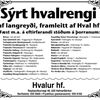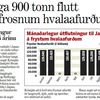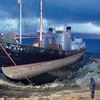Ķsland & atvinnuveišar, góšar greinar į ensku.
28.5.2007 | 16:47
ICELAND AND COMMERCIAL WHALING
ICELAND'S MEMBERSHIP
In 1982, the Commission took a decision, which came into force for the 1986 and 1985/86 seasons, that catch limits for all commercial whaling would be set to zero (i.e. the commercial whaling moratorium). A number of countries, but not Iceland, objected to this decision. Iceland left the IWC in 1992. By 1994 the Scientific Committee had developed and the Commission adopted the Revised Management Procedure (RMP) for commercial whaling; this is a scientifically robust method for calculating safe catch limits. This has not been implemented, awaiting agreement from the Commission on the Revised Management Scheme (RMS) which comprises additional non-scientific matters including inspection and observation.
Iceland re-adhered to the 1946 International Convention for the Regulation of Whaling on 10 October 2002. Its instrument of adherence included a reservation to the commercial whaling moratorium. The text of the reservation is as follows:
‘Notwithstanding this, the Government of Iceland will not authorise whaling for commercial purposes by Icelandic vessels before 2006 and, thereafter, will not authorise such whaling while progress is being made in negotiations within the IWC on the RMS. This does not apply, however, in case of the so-called moratorium on whaling for commercial purposes, contained in paragraph 10(e) of the Schedule not being lifted within a reasonable time after the completion of the RMS. Under no circumstances will whaling for commercial purposes be authorised without a sound scientific basis and an effective management and enforcement scheme.'
The reservation was not acceptable to all IWC member governments, although at a Special Meeting of the Commission in Cambridge, UK on 14 October 2002, a majority of governments voted to accept Iceland as a member. Further details of Iceland's re-adherence can be found HERE.
PRESENT STATUS OF RMS DISCUSSIONS
The Commission, while adopting the RMP, agreed not to lift the commercial whaling moratorium until an RMS is in place to ensure that agreed catch limits are not exceeded1. The Commission has been working on such a regime for many years but has not yet reached agreement. At the Commission's 58th Annual Meeting in St. Kitts and Nevis in June 2006, the Commission confirmed its view that discussions on the RMS remain at an impasse and no further collective work was scheduled. It was understood, however, that this does not prevent individual governments or groups of governments working together on the RMS if they so choose.
IUCN CATEGORIES AND THE FIN WHALE
The IWC is not directly involved in the IUCN Red List process although some members of its Scientific Committee participate directly or indirectly in providing advice. Given the recent increase in queries over the classification of fin whales, the following summary is intended to provide the interested reader with some factual background.
A detailed description of the Red List process can be found on the IUCN website.
The first thing to note is that at present, the classification of fin whales applies to the species worldwide (called ‘populations' in the very specific IUCN terminology) not to ocean areas or ‘populations' in the traditional biological sense. The IUCN Red List Categories and Criteria were designed for global taxon assessments. When applied at national or regional levels, IUCN notes that ‘it must be recognized that a global category may not be the same as a national or regional category for a particular taxon', thus regional populations may be either more or less threatened than the global assessment.
The fin whale species as a whole was classified as ‘Endangered' under the IUCN system in 1996 using their 1994 criteria. The classification of Endangered can be made on the basis that the species fulfils at least one of five major and wide ranging criteria. Its definition is:
‘A taxon is Endangered when it is not Critically Endangered but is facing a very high risk of extinction in the wild in the near future, as defined by any of the criteria ....'
It was noted2 that the current status of fin whales ‘is poorly known in most areas outside the North Atlantic'. The global categorisation of ‘Endangered' was made on the basis of one of the criteria, namely ‘an estimated decline of at least 50% worldwide over the last three generations (assumed generation time 20-25 years).....the greatest decline was in the Southern Hemisphere, which had the largest original population'. It should be noted that there will be a major review of the IUCN Cetacean Red List in January 2007, although this will again be at the global level.
MOST RECENT ABUNDANCE ESTIMATES OF COMMON MINKE AND FIN WHALES AROUND ICELAND
The most recent (2001) abundance estimate of common minke whales in Icelandic coastal waters is 43,600 (approx 95% confidence intervals of 30,100 - 63,100). This abundance estimate was agreed by the IWC's Scientific Committee at its Annual Meeting in 2003.
The most recent (2001) estimate of abundance of fin whales for the area off west Iceland (the ‘East Greenland Iceland stock') was 25,800 (approx 95% confidence intervals of 20,200 - 33,000). This abundance estimate was first agreed at a joint NAMMCO/IWC Workshop in early 2006 and confirmed by the IWC Scientific Committee at its Annual Meeting in 2006.
Experts extol tasty, nutritious whales
BENEFITS: Beyond the vitamins and minerals, there's a spiritual element.![]()
![]()
![]() Ice's unusually early retreat hinders community hunts
Ice's unusually early retreat hinders community hunts![]()
By DOUG O'HARRA
Anchorage Daily News![]()
(Published: November 24, 2003)![]()
![]()
![]() Ice's unusually early retreat hinders community hunts
Ice's unusually early retreat hinders community hunts
Here's a miracle meal. An excellent source of protein chock full of vitamins. Extra high in iron and other important minerals and laced with those omega-3 fatty acids that drive down cholesterol and boost overall health.Reach Daily News reporter Doug O'Harra at do'harra@adn.com.
Even better, the people who eat it say it's tasty and gives a spiritual boost.
This is not some breakfast flakes fortified by a snappy slogan or microwave entree in a snazzy box. It's the Alaska beluga whale, an ancient source of food in more than 50 villages along the Bering Sea and Arctic Ocean.
And according to hunters, health officials and biologists meeting last week with the Alaska Beluga Whale Committee, a strip of half-dried backstrap dipped in whale oil, or a chunk of aged beluga skin with blubber, may be one of the soundest meals available to coastal Natives and their families.
"To me, it gets me more healthy," said Allen Atchak Sr., a whaling captain from Stebbins who feeds his family of seven children lots of beluga meat and muktuk. "I don't ever get sick. I don't ever get bad colds. I think it's medicine."
"It's always good to catch whales," added Albert Simon, a beluga hunter from Hooper Bay. "That's why not too much is wasted."
Atchak, Simon and about 40 other hunters, scientists and visitors discussed the nutritional benefits and preparation of beluga whales during the group's annual meeting last week at the Hotel Captain Cook in Anchorage. Hunters also shared harvest reports and observations from the past season and talked over research ideas for 2004.
About 65,000 whales live in four Alaska stocks in the Bering Sea and Arctic Ocean, and Alaska Natives take 200 to 400 of them each year in hunts co-managed by the committee and the National Marine Fisheries Service under the federal Marine Mammal Protection Act. These whales are genetically separate from the 300 to 400 belugas listed as depleted in Cook Inlet near Anchorage.
With about $200,000 per year of federal funding, the committee has compiled 16 years of detailed harvest records, monitored and reduced struck-and-loss rates, sponsored aerial surveys and pioneering satellite tagging projects, and provided more than 900 tissue samples for genetic analysis by scientists at federal laboratories.
As time passed, the committee developed a reputation for hard work and reliable data that probably headed off interference by the International Whaling Commission, said Kathy Frost, a former state marine mammal specialist who helped set up the group and still serves as its secretary.
Last year, the group won the national Environmental Hero Award from the National Oceanic and Atmospheric Administration.
"It's you taking care of your own belugas," Frost told the hunters during the meeting. "It's not somebody else telling you what to do. You're taking care of it yourselves, and you're doing a good job."
One theme this year was eating the whales and what the benefits are.
Enormous, said Dr. Jim Berner, director of community health with the Alaska Native Tribal Health Consortium.
In recent years, scientists and Natives have questioned whether industrial contaminants and heavy metals that work through the global food chain and concentrate in tissues and muscles of marine mammals were making traditional foods like belugas too risky to eat.
As he has at other forums, Berner told the group emphatically that eating beluga whales and other subsistence foods offers incredible nutritional rewards.
It is true that, like other marine animals, belugas have been found to build up mercury, Berner said. But they also have elevated levels of the mineral selenium and vitamin E that may help counteract mercury.
Someone eating food harvested from the ocean off Alaska would be far better off than someone eating only processed food bought in the grocery store.
"This diet has sustained and benefited Alaska Natives and other people in the North for thousands of years, and we're recommending it," he told the hunters. "The benefits outweigh the risks considerably."
Beluga meat is especially rich in iron because the animal is an efficient diver. Like that of seals, the blubber contains the sort of fat found to reduce heart disease and boost immune systems. The whales have minerals and fat-soluble vitamins.
"It's hard to find a similar food that has all that in the diet," he said later.
Committee chairman Ross Schaeffer told the group that three days in Anchorage eating restaurant meals gets his system "messed up."
"When I finally eat my Native food, it's like my body is satisfied, on an even keel," he said.
At one point, hunters divided into groups from various regions to write down how they prepare and process the whales.
A group from Norton Sound described how every hunter would help butcher the whales, each providing food for up to 10 families at a time. The meat would be taken off in four sections, then cut into strips, hung and "half dried." Some people liked to dip it in seal oil or whale oil, while others liked to fry it. Muktuk, or the skin with blubber attached, would be cut into pieces or frozen for later meals.
"I do it the modern way," said Elim hunter Charlie Saccheus, a key member of the committee, bringing laughter from his group. "I get those two-gallon Ziploc bags with the zipper on top. I measure the muktuk the size of the bag and freeze it."
But the whales do more than sustain the body. In a presentation titled "Native foods -- more than just science," Schaeffer said hunting, processing and then sharing beluga with families and elders can do things for a man's spirit that may be hard to quantify with the scientific method.
"You treat every animal with utmost respect after the hunt," he said. "When the butchering process began, you didn't do it just any old way. You do it in a certain way. ... When you got this food home, you were taught to eat this food with thankfulness.
"When I eat Native food, I always say something like 'This is so good,' and it is good. It is spiritual."
He described an incident years ago in which hunters from different villages were arguing over who had rights to hunt the whales at a certain point along the coast. Elders warned no one should wrangle over the whales. Later, Schaeffer said, belugas became more scarce in the Kotzebue Sound area. Was there a lesson?
He remembered an elder he often visited: "I always enjoyed eating with him because he said, 'Eskimo food always tastes good when you have good company.' In my opinion, that really says it. This nikipaq, this Eskimo food, is a gift from our creator, and it must be shared."
Fengiš aš lįni frį www.hrefna.is
Meginflokkur: Vķsindi og fręši | Aukaflokkur: Bloggar | Breytt s.d. kl. 17:07 | Facebook









Bęta viš athugasemd [Innskrįning]
Ekki er lengur hęgt aš skrifa athugasemdir viš fęrsluna, žar sem tķmamörk į athugasemdir eru lišin.